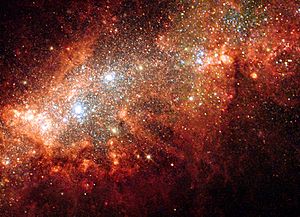NGC 1569 facts for kids

NGC 1569 is a small, oddly shaped galaxy found in the Camelopardalis constellation. It's called a dwarf irregular galaxy because it's not very big and doesn't have a regular shape like a spiral or oval. Scientists love to study this faint galaxy to learn how stars have formed inside it over time. Because it's fairly close to us, the Hubble Space Telescope can easily see its individual stars. In 2008, experts using Hubble's pictures figured out that NGC 1569 is almost 11 million light years away. It's part of a group of galaxies known as the IC 342 group.
Contents
What is a Starburst?
The most exciting thing about NGC 1569 is its powerful starburst. A starburst is when a galaxy suddenly starts making new stars much faster than usual. For the last 100 million years, NGC 1569 has been forming stars 100 times faster than our own Milky Way galaxy!
This galaxy has two very important groups of stars called super star clusters. These clusters are like giant nurseries where many stars are born close together. Each cluster has its own unique story.
Super Star Cluster A
Super star cluster A is in the northwest part of the galaxy. It's actually made of two smaller clusters very close to each other, named NGC 1569 A1 and NGC 1569 A2.
- NGC 1569 A1 has very young stars, including special ones called Wolf–Rayet stars. These stars are huge, hot, and very bright. They formed less than 5 million years ago.
- NGC 1569 A2 contains older, redder stars.
Super Star Cluster B
Super star cluster B is found closer to the center of NGC 1569. The stars here are older. Many of them are red giants or red supergiants. These are stars that have grown very large and cool down as they get older.
Both of these super star clusters are as massive as the globular clusters found in our Milky Way galaxy. Globular clusters are very old, tightly packed groups of stars. NGC 1569 also has many smaller star clusters. These are quite young, ranging from 2 million to 1 billion years old. They are similar to small globular clusters or even the famous R136 cluster in the Large Magellanic Cloud.
This shows scientists that star formation in small galaxies like NGC 1569 doesn't happen all the time. Instead, it happens in short, powerful bursts. We see similar bursts in other dwarf galaxies, like the Large Magellanic Cloud and NGC 1705.
How Starbursts Affect Galaxies
When many stars are born quickly, they also die quickly. Many of these massive stars end their lives in huge explosions called supernovae. These explosions, along with strong winds of gas coming from very hot stars (called stellar winds), push gas and dust away.
In NGC 1569, these powerful forces have created long, glowing clouds and bubbles of gas. This gas is mostly hydrogen that has become ionized, meaning it has lost some of its electrons. These glowing clouds are called emission nebula. They can be very large, up to 3,700 light years long! They glow because the light from the young, hot stars inside them hits the gas, making it shine.
Scientists think that NGC 1569's starburst might have been caused by other galaxies in its group. It probably had a close encounter with a nearby cloud of hydrogen gas, which triggered all the new star formation.
See also
 In Spanish: NGC 1569 para niños
In Spanish: NGC 1569 para niños

